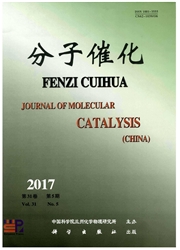

 中文摘要:
中文摘要:
采用不同沉淀剂制备了MgO材料,以其为载体制备了Ba-Ru/MgO氨合成催化剂,考察了沉淀剂种类和BaO助剂对其氨合成性能的影响.通过X射线衍射(XRD)、N2物理吸附、X射线荧光光谱(XRF)、透射电镜(TEM)、H2程序升温还原(H2-TPR)、CO2程序升温脱附(CO2-TPD)、H2程序升温脱附(H2-TPD)和N2程序升温脱附(N2-TPD)表征手段,对不同沉淀剂影响Ba-Ru/MgO催化剂氨合成性能的原因进行了探索.结果表明:采用(NH4)2CO3作沉淀剂制备的Ba-Ru/MgO催化剂表面Ru物种易于在低温下还原,催化剂表面在低温区具有较多数量的弱碱性吸附位,在450℃、5.0 MPa和5 000 h-1条件下,由(NH4)2CO3做沉淀剂制备的Ba-Ru/MgO催化剂活性最高,出口氨浓度为3.74%.BaO助剂的加入大大减少了Ba-Ru/MgO催化剂表面吸附氢的数量,增大表面脱附氮的数量,从而易于N2解离吸附,提高氨合成反应速率.
 英文摘要:
英文摘要:
MgO supports were prepared by different precipitants and further examined as the supports for barium-promoted ruthenium catalyst for ammonia synthesis.The reason resulting in their difference of catalytic activity were explored by X-ray diffraction,N2 adsorption-desorption,X-ray fluorescence spectroscopy,transmission electron microscopy,H2 temperature-programmed reduction,CO2 temperature-programmed desorption,H2 temperature-programmed desorption and N2 temperature-programmed desorption.It was found that MgO prepared by(NH4)2CO3 precipitant facilitated the reduction of ruthenium oxide for Ba-Ru/MgO catalyst,and the weak basic sites of Ba-Ru/MgO((NH4)2CO3 as precipitant) appeared at lower temperature and showed higher weak basic site densities compared with the others.At 450 ℃、 5.0 MPa and 5 000 h-1,catalytic activity of Ba-Ru/MgO catalyst employing(NH4)2CO3 as the precipitant was higher than that of the catalyst prepared by other precipitants under the same reaction conditions,the ammonia concentration in the effluent reached 3.74%.The addition of Ba promoter significantly decreased the amount of hydrogen chemisorption,increased the number of dissociatively adsorbed N* on the Ru surface and thus accelerated the reaction rate of ammonia synthesis.
 同期刊论文项目
同期刊论文项目
 同项目期刊论文
同项目期刊论文
 Enantioselective oxidation of secondary alcohols catalyzed by soluble chiral polymeric [N ',N '',bis
Enantioselective oxidation of secondary alcohols catalyzed by soluble chiral polymeric [N ',N '',bis Magnetically separable Pd catalyst for carbonylative Sonogashira coupling reactions for the synthesi
Magnetically separable Pd catalyst for carbonylative Sonogashira coupling reactions for the synthesi The synthesis of novel tetradentate ligands derived from salen and their application in enantioselec
The synthesis of novel tetradentate ligands derived from salen and their application in enantioselec Synthesis of salan (salalen) ligands derived from binaphthol for titanium-catalyzed asymmetric epoxi
Synthesis of salan (salalen) ligands derived from binaphthol for titanium-catalyzed asymmetric epoxi Synthesis and Structural Characterization of Silica Dispersed Copper Nanomaterials with Unusual Ther
Synthesis and Structural Characterization of Silica Dispersed Copper Nanomaterials with Unusual Ther Pyrrolidine-based Dicationic Acidic Ionic Liquids: Efficient and Recyclable Catalysts for Esterifica
Pyrrolidine-based Dicationic Acidic Ionic Liquids: Efficient and Recyclable Catalysts for Esterifica Synthesis of Tridentate Ligands Based on Chiral Diamines and Their Application to Enantioselective F
Synthesis of Tridentate Ligands Based on Chiral Diamines and Their Application to Enantioselective F Characterization and catalytic properties of the CuO/SiO2 catalysts prepared by precipitation-gel me
Characterization and catalytic properties of the CuO/SiO2 catalysts prepared by precipitation-gel me Synthesis, properties and catalysis of novel methyl- or ethyl-sulfate-anion-based acidic ionic liqui
Synthesis, properties and catalysis of novel methyl- or ethyl-sulfate-anion-based acidic ionic liqui Basic ionic liquids supported on hydroxyapatite-encapsulated gamma-Fe2O3 nanocrystallites: An effici
Basic ionic liquids supported on hydroxyapatite-encapsulated gamma-Fe2O3 nanocrystallites: An effici Synthesis of Novel Gemini Dicationic Acidic Ionic Liquids and Their Catalytic Performances in the Be
Synthesis of Novel Gemini Dicationic Acidic Ionic Liquids and Their Catalytic Performances in the Be Novel acidic ionic liquids mediated zinc chloride: Highly effective catalysts for the Beckmann rearr
Novel acidic ionic liquids mediated zinc chloride: Highly effective catalysts for the Beckmann rearr Lipase-catalysed kinetic resolution of secondary alcohols with improved enantioselectivity in propyl
Lipase-catalysed kinetic resolution of secondary alcohols with improved enantioselectivity in propyl Reaction of (Carbonyl)triruthenium with Acetylferrocene Thiosemicarbazone: Synthesis, X-ray Diffract
Reaction of (Carbonyl)triruthenium with Acetylferrocene Thiosemicarbazone: Synthesis, X-ray Diffract Highly dispersed silica-supported copper nanoparticles prepared by precipitation-gel method: A simpl
Highly dispersed silica-supported copper nanoparticles prepared by precipitation-gel method: A simpl Trinuclear Metal Cluster Complexes Containing Fischer-Type Carbene Group from Oxidative Addition Rea
Trinuclear Metal Cluster Complexes Containing Fischer-Type Carbene Group from Oxidative Addition Rea A simple and efficient recyclable phosphine-free catalytic system for alkoxycarbonylation and carbon
A simple and efficient recyclable phosphine-free catalytic system for alkoxycarbonylation and carbon Synthesis, crystal structure, and enantioseparation of a homometallic, chiral cluster [Ru-3(CO)(9){1
Synthesis, crystal structure, and enantioseparation of a homometallic, chiral cluster [Ru-3(CO)(9){1 Zr(OTf)(4)-catalyzed direct three-component Mannich-type reaction of carbamates: An efficient one-st
Zr(OTf)(4)-catalyzed direct three-component Mannich-type reaction of carbamates: An efficient one-st Biosynthesis of poly-3-hydroxybutyrate with a high molecular weight by methanotroph from methane and
Biosynthesis of poly-3-hydroxybutyrate with a high molecular weight by methanotroph from methane and The Mn(Salen)-catalyzed oxidative kinetic resolution of secondary alcohols: reaction development and
The Mn(Salen)-catalyzed oxidative kinetic resolution of secondary alcohols: reaction development and A magnetically recyclable heterogeneous catalyst: Cobalt nano-oxide supported on hydroxyapatite-enca
A magnetically recyclable heterogeneous catalyst: Cobalt nano-oxide supported on hydroxyapatite-enca A Pd(OAc)(2)/[mmim]I catalyst system for oxidative carbonylation of amines to carbamates, ureas, and
A Pd(OAc)(2)/[mmim]I catalyst system for oxidative carbonylation of amines to carbamates, ureas, and p-Toluenesulfonic acid mediated zinc chloride: Highly effective catalyst for the Beckmann rearrangem
p-Toluenesulfonic acid mediated zinc chloride: Highly effective catalyst for the Beckmann rearrangem 期刊信息
期刊信息
